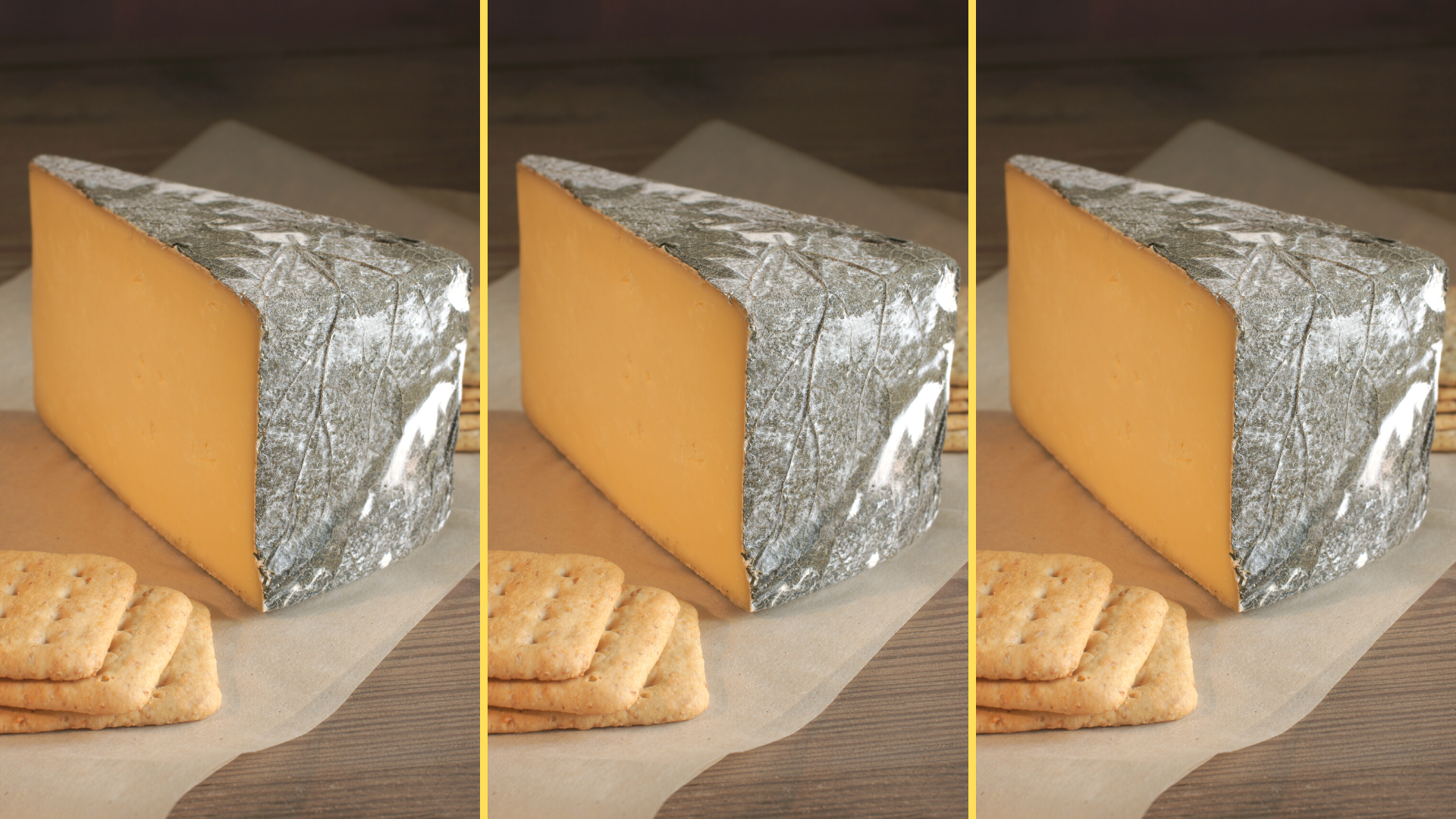Some of the links on this page are affiliate links, which means that Buzzy Kitchen earns commission from purchases made – at absolutely no extra cost to you. Thank you so much for supporting Buzzy Kitchen!
If, like me, you love a tasty little bit of cheese, but are a bit bored of eating the same old types over and over again, you should check out the cheese I’m talking about today! Cornish Yarg cheese is the name, and creamy-crumbliness is the game.
But let’s take a closer look at what Cornish Yarg cheese is, where to get it, what it tastes like, and how to eat it…
Essentially, here’s everything you should know about Cornish Yarg cheese!
What is Yarg Cheese?
Have you ever heard of Yarg cheese? It is sometimes called Cornish Yarg, and it is a type of cheese, made with cow’s milk, that is semi-hard… but also sometimes semi-soft.
Yarg cheese is a specialty cheese, created in just one place in the world. And, once you find out what – exactly – it is, you might feel the sudden urge to try it.
(Because I did. But, then again, I’m a bit of a cheese addict!)
What Sort of Cheese is Yarg?
Yarg cheese, or Cornish Yarg cheese, is a semi-hard cheese.
It is not soft, like Brie or Camembert. It’s not hard, either, like Parmesan or Romano. It sits somewhere in the middle – semi-hard and semi-soft.
The texture is crumbly and yet creamy, like many other semi-hard cheeses. The family of semi-hard cheeses also includes Gouda, Cheddar, Beaufort, and Gruyere.
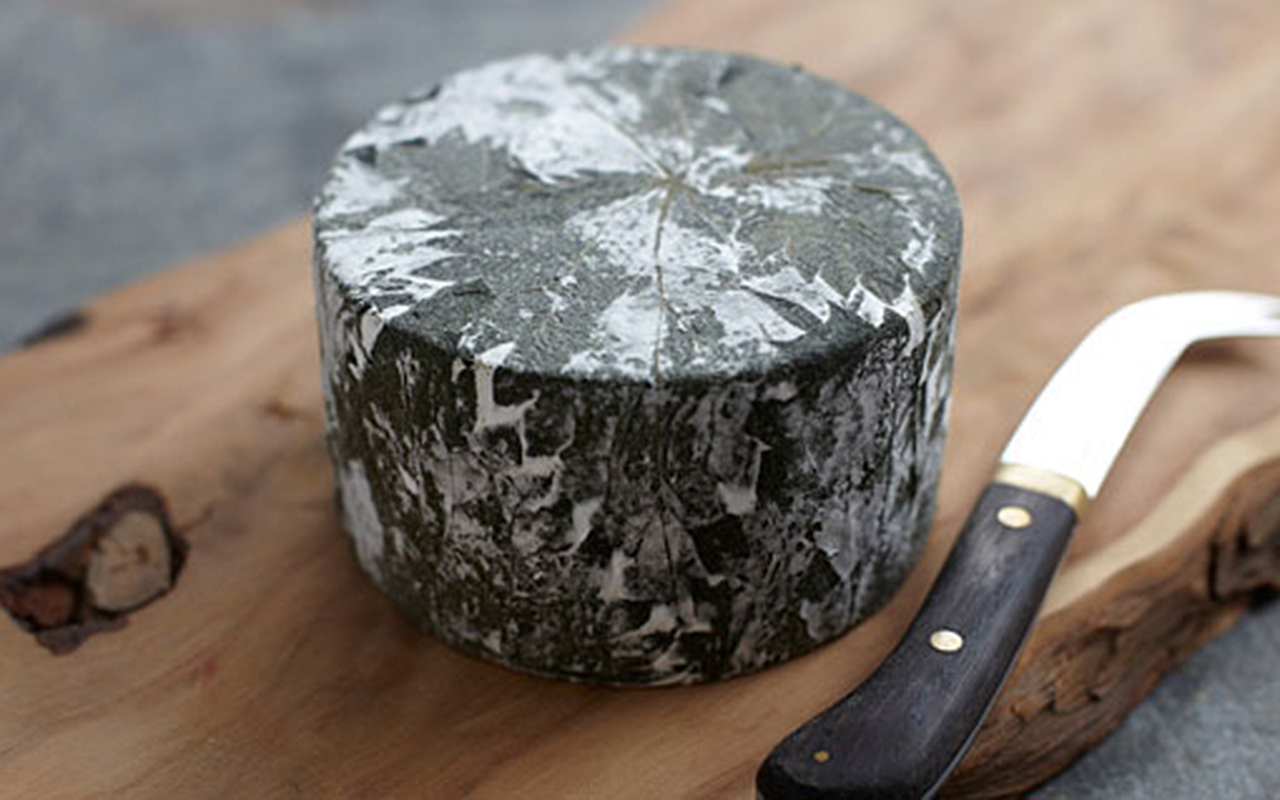
Cornish Yarg Cheese
Pong Cheese
Is Cornish Yarg Cheese Hard or Soft?
Cornish Yarg cheese is classed as a semi-hard cheese.
It is quite hard and crumbly, but it is also quite soft and creamy, all at the same time.
Other semi-hard cheeses include Gouda and Cheddar, the latter of which has a huge range – soft and creamy all the way up to super hard and crumbly.
What Does Cornish Yarg Cheese Taste Like?
Taste-wise, Cornish Yarg is often described as citrus-like, although it does depend on whether the cheese has been wrapped in stinging nettles or garlic nettles/leaves. As you can probably imagine, the latter incorporates more of a garlic taste throughout, but it is still quite subtle.
Official Cornish Yarg Description:
Cornish Yarg is a nettle wrapped semi hard cheese made from grass rich Cornish milk. Tangy under its natural rind and slightly crumbly in the core, it consistently wins top international awards.
Lynher Dairies Cheese Company
Is Cornish Yarg Goat’s Cheese?
No, Cornish Yarg is not goat’s cheese.
This type of cheese is made from cow’s milk – and all of the cows are local to Lynher Dairies in Cornwall and surrounding farms.
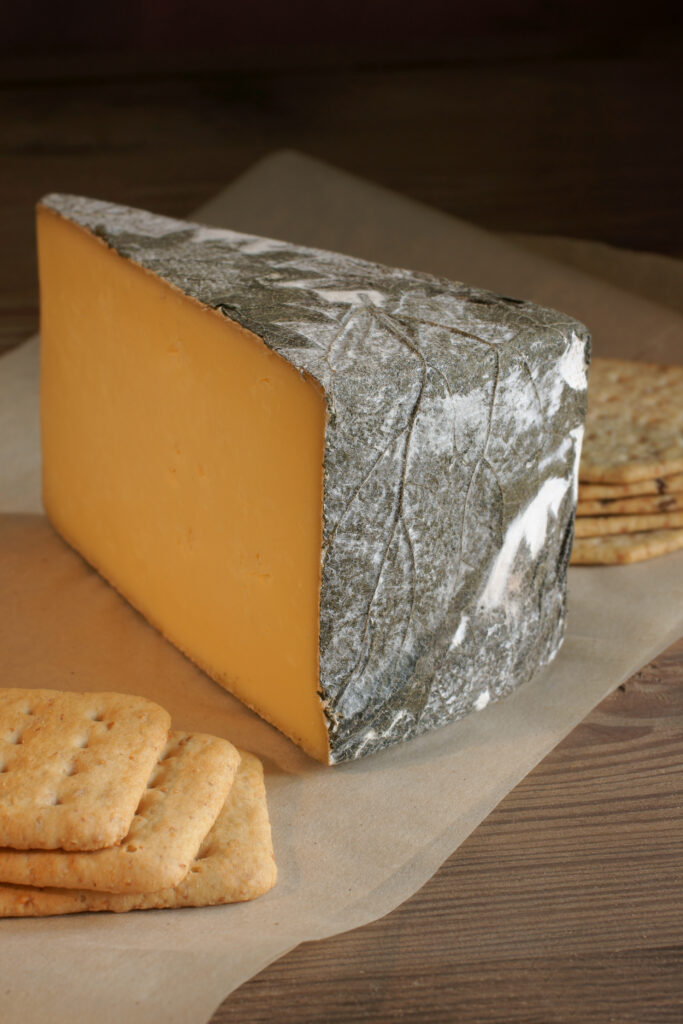
Is Cornish Yarg Vegan?
No, Cornish Yarg cheese is not vegan.
Yarg cheese is made from cow’s milk, which vegans would typically not consume.
Is Cornish Yarg Vegetarian?
Cornish Yarg is made from cow’s milk, which means it isn’t safe for vegans. There are no actual meat products in Yarg cheese, however.
Cornish Yarg cheese is vegetarian-friendly.
How Long Does it Take for Cornish Yarg Cheese to Mature?
Cornish Yarg cheese is usually matured, wrapped in nettle leaves, for a minimum of 21 days.
The maturing process takes place in quite specific circumstances: the temperature needs to be cool enough to allow the cheese to be preserved, but with just the right amount of humidity to allow the nettles to decompose and do their job at encouraging the growth of mould.
Where is Yarg Cheese Made?
Cornish Yarg cheese is made in Cornwall, at Lynher Dairies Cheese Company, not far from Truro.
Everything about the cheese is local. The milk is sourced from local cows, and the nettles wrapped around the cheese are harvested from the surrounding Cornish countryside.
According to the Lynher Dairies website, the milk comes from their own herd of Ayrshire cows, as well as cows from local farms in Cornwall. All of that lovely, calcium-rich milk is then turned into tasty and delightful cheeses, by hand, in open vats, according to a slightly adapted 13th century recipe.
Who Makes Cornish Yarg Cheese?
The company behind Cornish Yarg cheese is Lynher Dairies.
The dairy is the only place in the world in which the award-winning Yarg variety 0f cheese is produced.
Cornish Yarg isn’t the only cheese that the company creates, either. There is a garlic version, called Wild Garlic Yarg.
If semi-hard cheeses aren’t your thing, you could always give Cornish Kern cheese a try, which has a recipe that originates from Gouda cheese.
And, if you fancied your Cornish Yarg cheese in its nude form, you might like the sound of Stithians. It is essentially Yarg without the nettles. The nettles alter the way the cheese matures, so Stithians is quite different from Yarg in both taste and texture.
Why is Yarg Called Yarg?
I know you’re probably expecting me to share a super interesting story about the name of this type of cheese, but the answer to the question is actually super simple… and actually not that interesting!
Yarg is ‘gray’ spelled backwards.
Gray was the surname of the couple who initially created the recipe of Cornish Yarg cheese that we know and love today.
Jenny and Alan Gray, from Withiel, took their surname, reversed it, and made that the name of their cheese, which came from an old recipe that they found in their attic. The recipe dated back to the 16th century, but the actual, original recipe is believed to have originated from the 13th century.
The business has been sold to new owners since then, and the Lynher Dairies list of cheeses has grown.
Can You Only Get Yarg Cheese in Cornwall?
Cornish Yarg cheese is only made-slash-produced in Cornwall, but you can buy it from other places in the UK.
Online is perhaps the easiest option, but there are in-store places to buy it from, too.
If your local butcher stocks local or speciality cheeses, it is worth having a chat with them to find out if they can get Cornish Yarg cheese in stock. Small and local cheese-selling boutiques are another great option.
Most local spots like these will be more than happy to get a certain item, such as speciality cheese, in for you. You just need to ask!
Where Can I get Yarg Cheese?
You can buy Yarg cheese direct from the people who make it — Lynher Dairies.
I have also done a little bit of research (so you don’t have to) and found Cornish Yarg cheese in the following places:
| Store | Availability & Details |
|---|---|
| Amazon | £29.95 / 1kg (Whole wheel) |
| Asda | ❌ |
| Morrisons | ❌ |
| Ocado | ❌ |
| Pong Cheese | £8.50 / 250g (approx) |
| Sainsbury’s | ❌ |
| Tesco | ❌ |
What is Similar to Cornish Yarg Cheese?
Cornish Yarg cheese is quite unique, not just in the fact that it is wrapped in nettles, but also because of the change between soft and semi-hard cheese, and also because of the way the nettles make the matured cow’s cheese taste. It has a bit of a citrus twang to it, although it is a very light twang.
Two cheeses that are commonly compared to Cornish Yarg cheese are Cheddar, and also Caerphilly. Reports suggest that the original Cornish Yarg recipe was actually taken from an older-style Caerphilly one, that originated in the 13th century.
The cheese around the outside of the wheel, closest to the nettles, is semi-hard and crumbly, just like Caerphilly and Cheddar.
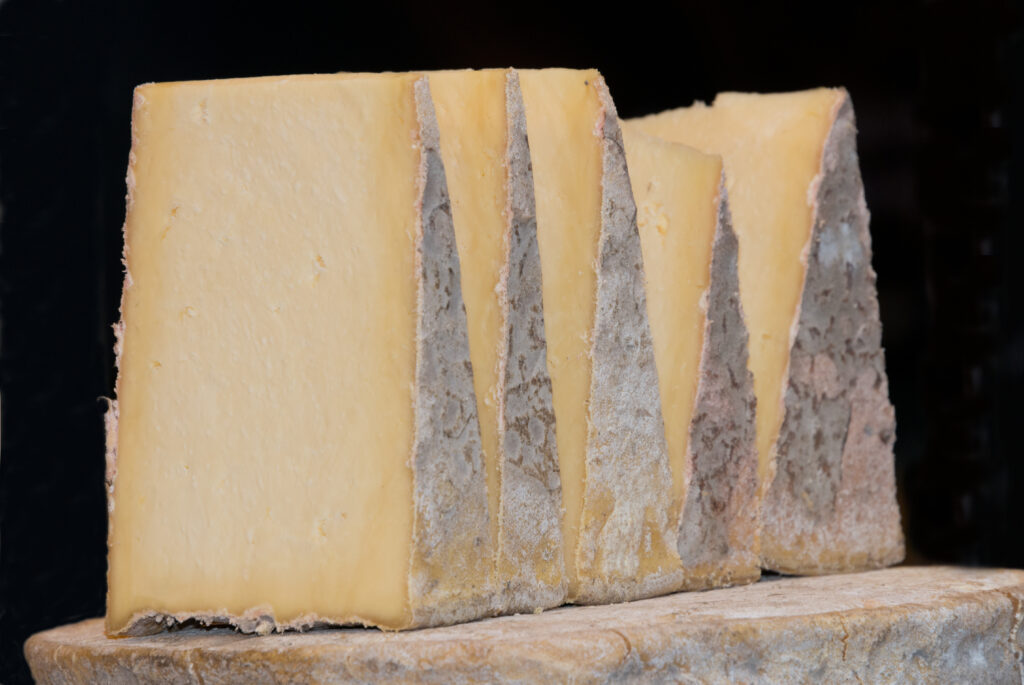
Yarg is also quite a creamy cheese.
The closer you get to the centre of the wheel, the softer the cheese is. It is a little more semi-soft than semi-hard, because the effect of the nettles hasn’t quite reached that point.
The longer the cheese is matured, the more hard and crumbly it becomes throughout.
What Can I Do with Cornish Yarg Cheese?
You can actually use Cornish Yarg cheese in many of the same places – and ways – that you would your ‘regular’ cheese, such as Cheddar. For example, you might enjoy some Yarg on toast for breakfast, or grate/cut a little Yarg to throw in your omelette or scrambled egg.
Yarg cheese would also make a great (and likely new) addition to a cheeseboard, enjoyed with friends and a bottle of wine or two.
Are you having a BBQ soon? You could carve up thin slices of Cornish Yarg cheese to add to cheeseburgers instead of cheese slices.
If you’re looking for something new to crumble on the top of your spaghetti bolognese, you could do far worse than using a little Yarg cheese.
Yarg cheese also works particularly well in summer salads, because of the light citrusy twang in the taste. Cube it or crumble it over a summer salad instead of your regular cheese, and see what you think.
Why is Yarg Cheese Wrapped in Nettles?
The wrapping of the nettles is actually what gives Yarg cheese its traditional characteristics.
This includes the light and zesty citrus taste, the semi-hard and crumbly texture, and the creaminess.
The nettles themselves are sourced from the rolling hills and countryside of Cornwall. Once the cheese has been made in open vats, then poured into moulds, then soaked in salt water (also known as brined), the nettles are applied to the outside of the cheese wheel or mould, in a particular and very specific pattern – concentric circles.
The nettle leaves, when applied to the cheese, encourages the growth of mould. This might sound rather unpleasant, but mould is the secret ingredient behind many a cheese variety.
(Just take a look at the Cheese section of Buzzy Kitchen if you don’t believe me!)
Inside the nettle wrap, the cheese matures as cheese naturally does. On the outside, the nettles encourage the growth of said mould, which acts as a rind or skin. At the same time, the nettles help to infuse a natural, almost earthy taste.
The nettles – and the mould/rind layer – is what makes Yarg as tasty and unique as it is.
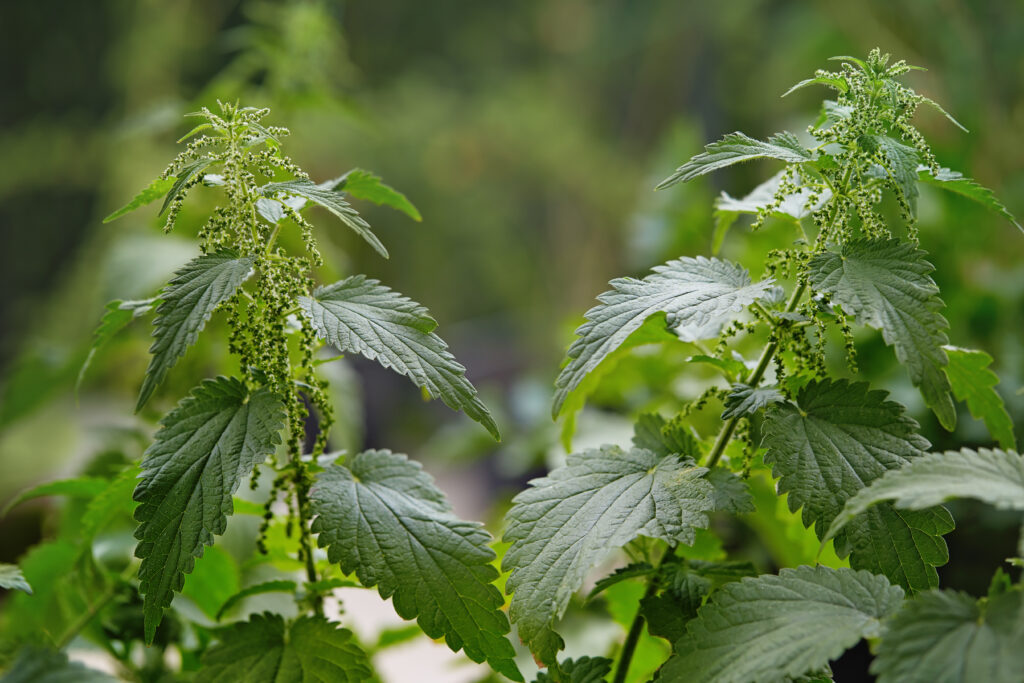
What Leaves are Wrapped Around Cornish Yarg Cheese?
The leaves that are wrapped around Yarg cheese will depend a little bit on what kind of taste or finish the cheese is going to have.
The leaves that are wrapped around traditional Yarg cheese are stinging nettle leaves, also known as Urtica dioica.
Stinging nettle leaves are edible. In fact, they are used in many cultures and countries for nutritional and medicinal purposes.
You can buy Yarg cheese without the nettles wrapped around. The “unwrapped” version of the cheese is known by the name Stithians.
Do You Eat Cornish Yarg Nettles?
The nettles that are wrapped around Cornish Yarg cheese are usually (and traditionally) completely edible, as is the rind or skin that often toughens up the exterior of the wheel.
It is definitely recommend to check the packaging before you eat the nettles, however. Some cheese experts recommend not eating the nettles.
Most people choose not to eat these parts of the cheese, however. The skin or rind, especially, can be very chewy and tough to eat, and in some places, it can be very thick.
What’s the Best Way to Store Cornish Yarg Cheese?
According to Lynher Dairies, the dairy that actually makes the cheese, the best way to store Cornish Yarg cheese is wrapped up in wax paper, and in a place that has a temperature 8C or lower.
The dairy also suggests serving Yarg at room temperature.
If you are planning to store this cheese in the fridge, you should take it out a little bit before you are due to serve it, to let it come to room temperature.
Can You Freeze Yarg Cheese?
You can freeze Cornish Yarg cheese…
… but you might find that the texture changes once you defrost it.
Semi-hard cheeses, such as Yarg and Cheddar, are freezable. They freeze pretty well, but when it comes to thawing them out at the other end, when you are ready to eat them/cook with them, things change.
Semi-hard cheeses tend to become more crumbly and harder when they are frozen. This makes them much harder to slice, because they just fall apart whenever you touch them.
If you are going to freeze Cornish Yarg cheese (or other semi-hard cheeses), it is recommended to cook with it when you defrost it rather than eat it in its raw from.
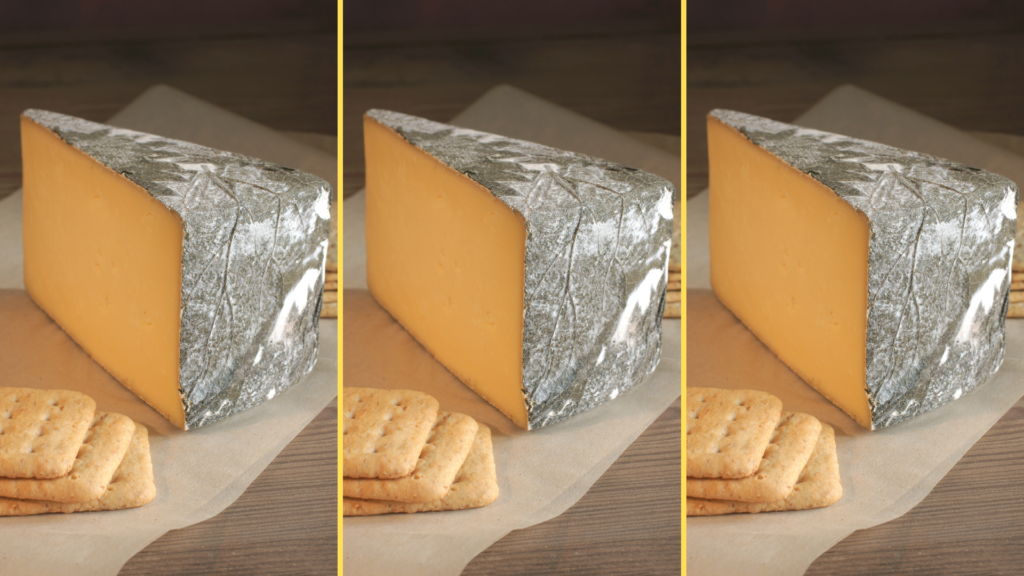
Yarg Cheese and Wine Pairing Suggestions
According to the experts, you have a few options when it comes to selecting the right wine for Yarg cheese.
Wine Folly, for example, suggests pairing “mouldy” cheeses with sweet wines – such as Stilton with port.
Wine Folly also recommends pairing your cheese with a wine from the same region, so if you happen to find a nice wine that’s been produced in Cornwall, you might want to pick that up while you’re there.
Serious Eats has some great advice for finding the right wine pairing for your Cornish Yarg cheese. The website suggests pairing the stronger flavours of semi-hard cheeses with medium-bodied wines from the white range, or red wines that have a fruity twang to them. This includes Chardonnay, Pinot Blanc, Merlot and Port.
If you want a wine pairing that works well with almost all cheeses, you should pop open that bottle of literal bubbly – sparkling wine or champagne.
